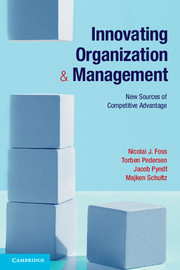Chapter 4 - Vestas
The will to win(d)
Published online by Cambridge University Press: 05 June 2012
Summary
It was with a sense of ambiguity that Ditlev Engel, CEO of the Danish wind turbine manufacturer Vestas Wind Systems, gave his speech at the annual meeting of the Confederation of Danish Industries in 2007. On the one hand, he saw the annual meeting as a unique opportunity to propagate key messages about Vestas and its global role in defining modern energy. On the other hand, he found himself in front of an audience with backgrounds in various industrial companies, companies that had characteristics different from those of Vestas. He pondered whether they fully grasped the dynamics of the wind industry and the global challenges facing Vestas. Of course, Vestas enjoyed the attention and interest it received from business practitioners, the political community, and the general public. In fact, it was one of the most traded stocks on the Copenhagen Stock Exchange and had a relatively large number of private investors as shareholders. Within the Confederation of Danish Industries, it was regarded as one of the crown jewels with respect to technology and know-how. However, while it acknowledged its affiliation with those companies within the Confederation, Vestas’s self-understanding, mindset and modus operandi were more similar to those of IT companies. These companies typically operated with growth scenarios of 30 percent per annum and swift decision-making processes. Touching upon this dilemma in his speech, Engel explained:
In Denmark, 20 per cent of our energy is from wind power. That number surprises and impresses people all over the world. Is 20 per cent that much? Yes. On a global level, the figure is 0.7 per cent. So there’s room for improvement or great possibilities. That’s why energy is high on the world’s agenda right now. Much has been happening. We heard from the EU that 20 per cent of our energy in 2020 must come from renewable energy. In the US, the new energy law is subject to much discussion. The House of Representatives suggests that in 2020, 15 per cent of electricity should come from renewable energy. If we then go to China, they’ve raised their percentage of renewable energy from 8 per cent to 15 per cent. According to China Daily and China itself, this corresponds to an investment of $265 billion. The focus is on wind and water. If we compare these numbers to the 0.7 per cent, then everyone can see what our world is like at Vestas, and why we sometimes feel that the agenda is off track compared to the big picture. (President and CEO Ditlev Engel, Annual Meeting of the Confederation of Danish Industries, September 2007)
Despite politicians’ receptiveness and sympathetic attitudes, Vestas did not always feel that they fully understood the big picture. When the Australian government announced its refusal to raise the mandatory renewable energy target (MRET), which was initially designed to support industrial growth, wind power advocates argued that billions of dollars in potential investment would evaporate. Vestas, for example, would reconsider its plans to build a turbine blade manufacturing plant in Tasmania, a multimillion dollar investment. Another example involved its application to install a number of test turbines off the Danish shore. The offshore market was a strategic priority but the turbines needed further testing prior to large-scale market penetration. When referring the issue to a committee, politicians had discussed it animatedly. However, as of spring 2008 no defining decision had been made, which stretched Vestas’s patience.
- Type
- Chapter
- Information
- Innovating Organization and ManagementNew Sources of Competitive Advantage, pp. 72 - 104Publisher: Cambridge University PressPrint publication year: 2012

